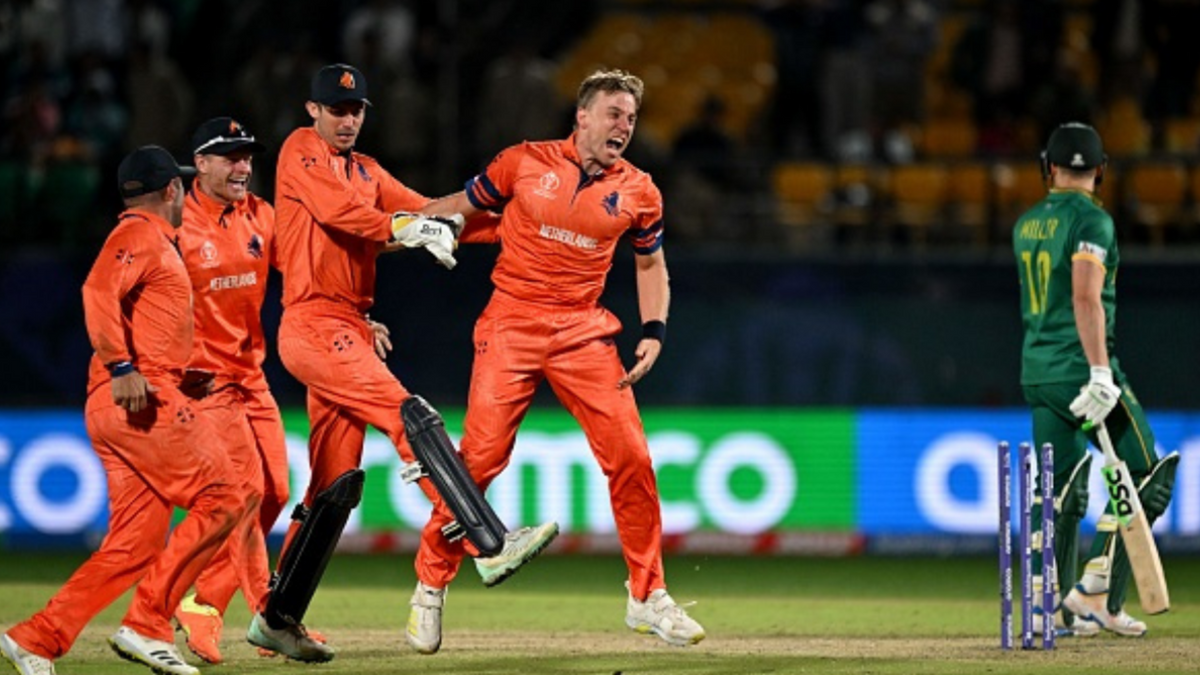
Netherlands defeated South Africa for a famous win in the 2023 World Cup and the victory was brought about by a number of well-thought-out plans, writes Sarah Waris.
To bet on the World Cup with our Match Centre Partners bet365 head here.
It was expected to be a one-sided encounter, with the Netherlands up against an unbeaten South African team, who had emerged as strong contenders after their batting displays in the first two games. Against the Dutch, however, they crumbled, falling to some excellent bowling that saw the Netherlands successfully defend 245 in 43 overs.
After being reduced to 140-7 in 33.5 overs, Netherlands were led by the never-say-die approach of skipper Scott Edwards (78* in 69) and Roelof van der Merwe (29 in 19), as they rescued the team, helping them notch 105 runs from the last 55 deliveries. It gave them something to bowl at and the absence of dew due to windy conditions after a three-hour rain delay further worked in their favour.
It allowed them the perfect conditions to stick to the plan they have followed in each of their previous games in this World Cup: starting with spin. Against Pakistan and New Zealand, right-hand off-break spinner Aryan Dutt was given the new ball, a tactic that did not change against South Africa.
With Quinton de Kock’s recent woes against slower bowling in the powerplay in ODIs this year, it made sense. Overall, the left-hander averages 27.2 against right-arm spinners in the first ten overs of ODIs, which falls to 12.5 this year at a strike rate of just over 68. De Kock faced only seven balls of Dutt and did not seem to have any trouble against him, scoring seven off seven against him. Undaunted by the ease with which he was batting against him, off-spinner Colin Ackermann was introduced by the Netherlands, in another bid to tap into de Kock’s perceived weakness. They got the desired result soon after as Ackermann’s extra bounce took out de Kock for a 22-ball 20.
That is when the (entirely legitimate) cheat sheets came out. Having written all their plans on slips of paper, Netherlands introduced left-armer Roelof van der Merwe in the tenth over to counter Temba Bavuma, who had been dismissed to left-arm slower bowlers 15 times across all formats before the game.
It wad only the second time van der Merwe was bowling in the powerplay of an ODI. The first instance was against New Zealand earlier in this World Cup, to counter the dangerous Devon Conway, who averaged 27 against left-hand spinners.
The Netherlands' 12th man tonight: paper. #NEDvSA pic.twitter.com/hgyuCgkYCp
— Aakash Sivasubramaniam (@aakashs26) October 17, 2023
It worked, almost on cue. Bavuma was bowled by a cunning slider for 16 on the first ball he faced off him and the windows opened for the Netherlands.
With hardly anything on offer for the bowlers and the ball not jagging off the surface, Paul van Meekeren sent down a cross-seam delivery that kept low to Aiden Markram, getting the ball to land on the shiny side and skid through. Markram, on his back foot, seemingly expected a shorter ball, but the quick pitched it up slightly, as the ball snuck through his defences.
This was the norm of South Africa’s innings, with their batters tending to hang back in general. Marco Jansen, expecting a short ball, too, was also bowled by another van Meekeren cross-seamer that skidded on, the two deliveries going down in Dutch folklore. Heinrich Klaasen, who started well, fell to a 129kmph slower ball by Logan van Beek, expecting the ball to have greater pace as he played the pull towards the fielder at fine leg.
According to Star Sports, only three per cent of the deliveries bowled by the Dutch were slower balls, as compared to South Africa’s 15 per cent, using them as effective weapons to mix things up. Gerald Coetzee and Kagiso Rabada both fell to the slower balls as did dangerman David Miller.
Edwards’ captaincy also stood out, for astute bowling changes, including not hesitating to bowl van der Merwe to the left-handed Miller. Aware that he was a threat, Edwards brought on his most experienced bowler, and the move would have worked, if not for a dropped catch by Bas de Leede when Miller was on 23.
By the end of the 25th over, the best bowlers of the day, van Meekeren, van der Merwe and Dutt had sent down six, seven and five overs, respectively, going against what most captains are often guilty of doing by saving them for the death overs.
Pakistan skipper Babar Azam has often been criticised for this move, which was recently used in the Asia Cup clash against India when the lethal quicks were traded in for the slower bowlers. Babar, and Pakistan, paid the price as India recovered to post a daunting score, but the Netherlands believed in stamping their authority on the game when they had it by the scruff of the neck.
Keshav Maharaj offered resistance to reduce the margin of defeat, which could be important down the line if Net Run Rate comes into play later in the tournament, but by then it was too late. In the end, the Netherlands’ win was not just a fluke but was brought about by some impressive decisions, sending out a clear message to the ICC that, if given opportunities, Associates could do more than fill in the gaps in world tournaments.








